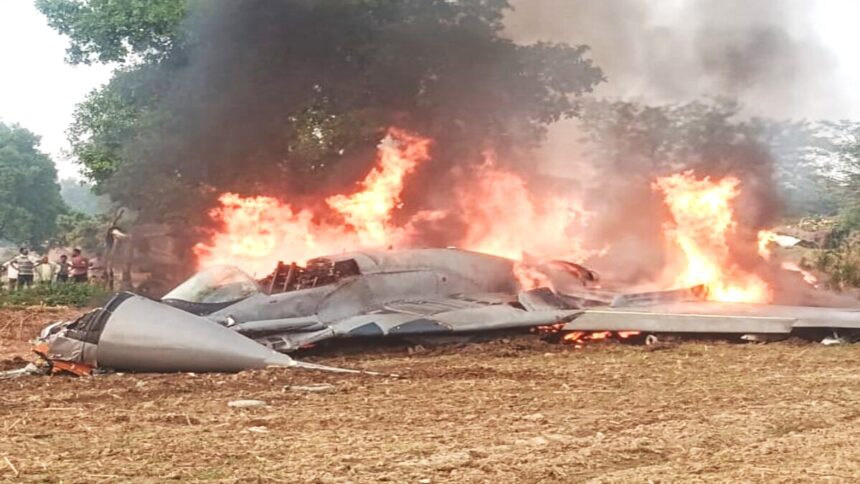In a dramatic incident today, an Indian Air Force (IAF) MiG-29 fighter jet crashed in an open field near Songa village, close to Agra, Uttar Pradesh. Fortunately, the pilot was able to eject safely before the aircraft went up in flames. This incident marks the second crash of a MiG-29 in the last two months, raising concerns about the aircraft’s operational safety.
Incident Overview
The MiG-29, known for its agility and air superiority capabilities, was on a routine training sortie when it encountered a “system malfunction.” As reported by the IAF, the pilot managed to maneuver the aircraft in such a way as to avoid causing damage to life or property on the ground. Witnesses described a scene of chaos as the aircraft plummeted before erupting into flames in the field.
Visuals from the crash site showed the burning aircraft surrounded by onlookers, who stood several feet away. Some people were seen holding what appeared to be parts of an ejection seat, underscoring the dramatic nature of the incident. Fortunately, the pilot was unharmed, and the IAF has since initiated an enquiry to investigate the cause of the crash.
🚨 Agra Plane Crash Alert: An IAF MiG-29 crashed near Agra but, thanks to the pilot's quick thinking, he and a companion ejected safely before impact, found two kilometers away. #indianairforce #planecrash #Mig29crash #aviationnews pic.twitter.com/CxRjBHiJNN
— praneeth chowdary (@praneethCH151) November 4, 2024The MiG-29: A Brief History
The MiG-29, known as the “Fulcrum” in NATO nomenclature and “Baaz” in India, was originally developed by the Soviet Union and first entered service in the early 1980s. India inducted the aircraft into its Air Force in 1987 and has since upgraded it to enhance its capabilities. The latest version, the MiG-29 UPG, incorporates advanced avionics and weapon systems, ensuring it remains competitive in modern aerial warfare.
Despite its long service history, the MiG-29 has maintained a relatively safe operational track record. However, today’s incident is a reminder that even well-regarded aircraft can experience significant issues. The IAF operates three squadrons of the upgraded MiG-29 UPG, and this incident raises questions about the aircraft’s reliability.
Previous Incidents
This crash is not an isolated event. Just two months ago, on September 2, another MiG-29 encountered a critical technical snag during a night training mission near Barmer in Rajasthan. In that case, the pilot also ejected safely, and there were no reported casualties or damage on the ground. These two incidents within a short span highlight a concerning trend that the IAF will likely scrutinize closely.
The MiG-29 is equipped with a Zvezda K-36D zero-zero ejection seat, one of the most advanced ejection seats in the world. This technology allows pilots to safely eject from the aircraft even at low altitudes, significantly increasing their chances of survival in emergencies. The successful ejection of the pilot today speaks to the effectiveness of this safety feature.
Eyewitness Accounts
Eyewitnesses to today’s crash described a terrifying scene. As the MiG-29 spiraled downward, many rushed to the area, drawn by the smoke and flames. Local residents expressed their relief that the pilot was able to eject safely, avoiding what could have been a tragic situation if the aircraft had impacted in a more populated area.
“After hearing a huge noise, I watched the plane spin down. One resident remarked, “It was terrifying.” “Fortunately, the pilot was able to steer it away from our homes, but we were all concerned about where it might land.”
Investigating the Cause
The IAF has confirmed that an enquiry has been ordered to ascertain the cause of today’s crash. Investigations will likely involve examining the aircraft’s maintenance records, the circumstances leading up to the malfunction, and the pilot’s actions during the emergency.
The IAF’s commitment to safety and accountability will be critical in addressing any underlying issues that may have contributed to this incident. Regular assessments and upgrades of aging fleets like the MiG-29 are essential to maintaining safety standards and ensuring pilot confidence.
The Future of the MiG-29 in the IAF
As the IAF looks to the future, it faces the challenge of balancing the operational needs of its existing fleet with the demands of modern warfare. The MiG-29 has served the Indian Air Force well for decades, but as newer aircraft are introduced, the focus will need to shift towards ensuring that older models remain safe and effective.
The recent crashes, particularly the frequency of technical malfunctions, may prompt the IAF to reevaluate its reliance on certain aircraft models. Continuous training, maintenance, and upgrades are vital to maintaining the operational integrity of any military force.
Today’s MiG-29 crash near Agra serves as a stark reminder of the risks inherent in military aviation. While the pilot’s safe ejection is a testament to the effectiveness of modern ejection technology, the series of recent incidents raises questions about the overall safety of the aircraft. The IAF’s commitment to a thorough investigation will be crucial in preventing future occurrences and ensuring the safety of its pilots and the communities surrounding its operations.
Read More: Canada Labels India a “Cyber Adversary”: A Diplomatic Tension Deepens






